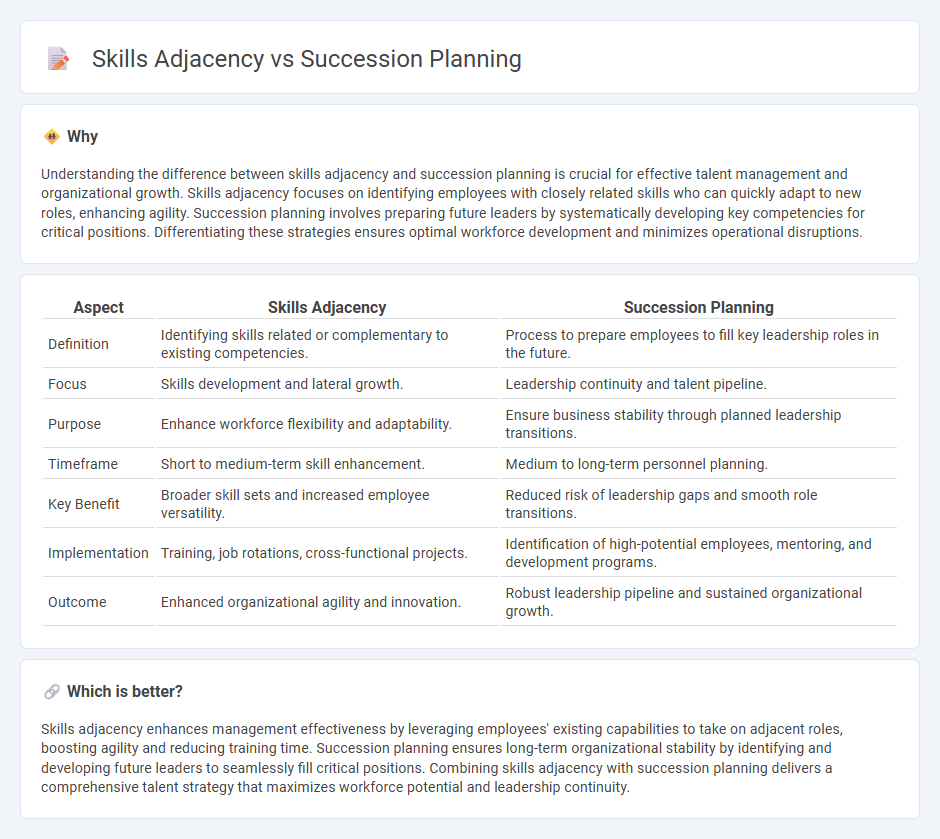
Effective management requires distinguishing between skills adjacency, which focuses on leveraging related competencies for immediate role expansion, and succession planning, a strategic process aimed at identifying and developing future leaders within the organization. Understanding the nuances between these approaches ensures optimized talent development and organizational resilience. Explore deeper insights into how skills adjacency and succession planning can transform leadership pipelines.
Why it is important
Understanding the difference between skills adjacency and succession planning is crucial for effective talent management and organizational growth. Skills adjacency focuses on identifying employees with closely related skills who can quickly adapt to new roles, enhancing agility. Succession planning involves preparing future leaders by systematically developing key competencies for critical positions. Differentiating these strategies ensures optimal workforce development and minimizes operational disruptions.
Comparison Table
| Aspect | Skills Adjacency | Succession Planning |
|---|---|---|
| Definition | Identifying skills related or complementary to existing competencies. | Process to prepare employees to fill key leadership roles in the future. |
| Focus | Skills development and lateral growth. | Leadership continuity and talent pipeline. |
| Purpose | Enhance workforce flexibility and adaptability. | Ensure business stability through planned leadership transitions. |
| Timeframe | Short to medium-term skill enhancement. | Medium to long-term personnel planning. |
| Key Benefit | Broader skill sets and increased employee versatility. | Reduced risk of leadership gaps and smooth role transitions. |
| Implementation | Training, job rotations, cross-functional projects. | Identification of high-potential employees, mentoring, and development programs. |
| Outcome | Enhanced organizational agility and innovation. | Robust leadership pipeline and sustained organizational growth. |
Which is better?
Skills adjacency enhances management effectiveness by leveraging employees' existing capabilities to take on adjacent roles, boosting agility and reducing training time. Succession planning ensures long-term organizational stability by identifying and developing future leaders to seamlessly fill critical positions. Combining skills adjacency with succession planning delivers a comprehensive talent strategy that maximizes workforce potential and leadership continuity.
Connection
Skills adjacency enhances succession planning by identifying employees with closely related competencies for future leadership roles. Mapping skill proximities allows organizations to target development programs that bridge gaps, ensuring smooth transitions and organizational continuity. Effective succession planning leverages skill adjacency to reduce talent shortages and accelerate leadership readiness.
Key Terms
**Succession Planning:**
Succession planning involves identifying and developing internal talent to ensure leadership continuity and minimize disruptions in key roles within an organization. It strategically aligns potential successors with critical positions based on leadership competencies, experience, and organizational needs. Explore how effective succession planning secures business resilience and drives long-term growth.
Talent Pipeline
Succession planning ensures a robust talent pipeline by identifying and preparing internal candidates for leadership roles, while skills adjacency emphasizes developing employees' complementary skills to enhance their versatility within the organization. Both strategies prioritize workforce readiness but differ in focus: succession planning targets future leadership needs, and skills adjacency promotes cross-functional capabilities to meet evolving business demands. Explore how integrating these approaches can create a dynamic and resilient talent pipeline tailored to your company's growth.
Leadership Development
Succession planning targets identifying and preparing high-potential leaders for future key roles, ensuring organizational continuity and leadership stability. Skills adjacency emphasizes developing related competencies that allow leaders to adapt and transition effectively across diverse functions and challenges. Explore how integrating both strategies can maximize leadership development and organizational resilience.
Source and External Links
Succession Planning: All You Need To Know [2025 Edition] - This comprehensive guide outlines the process of selecting and developing key talent to ensure continuity in critical organizational roles.
Succession Planning: 7-Step Guide & Template - This article provides a structured approach to succession planning, emphasizing identification, development, and preparation of potential successors for key roles.
Succession planning - It is a strategic process used to identify, develop, and maintain a pipeline of future leaders to fill critical roles within an organization.
 dowidth.com
dowidth.com